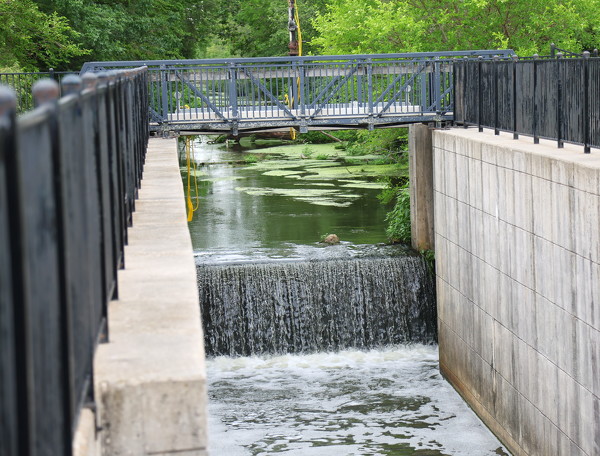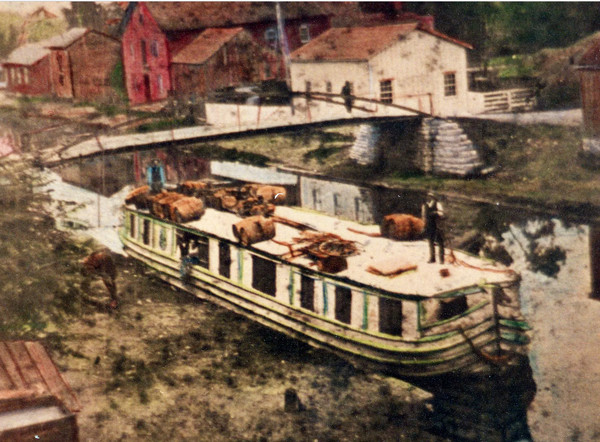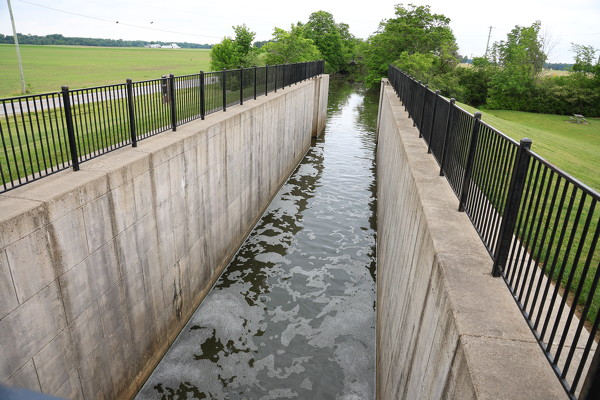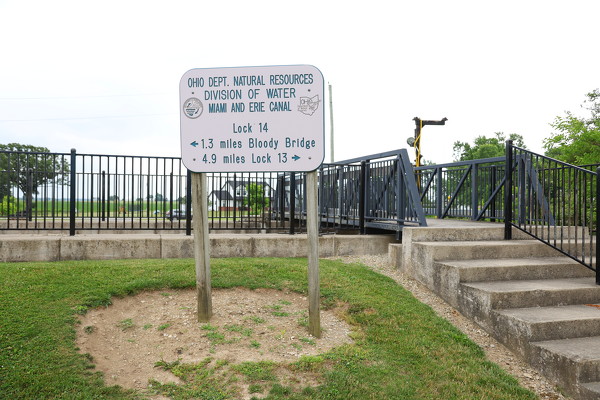
Water flows through Miami-Erie Canal Lock 14 located near Schillinger Road in St. Marys.
ST. MARYS - Towns along the Miami-Erie Canal were hubs for commerce during the mid-1800s, according to an area expert.
During a presentation Thursday at the St. Marys library, Neal Brady, volunteer executive director of the Miami-Erie Canal Corridor Association (MECCA) in New Bremen, said several area towns such as Minster, St. Marys and New Bremen have a vibrant history connected to the historic Miami-Erie Canal.
Ohio was part of the American frontier when it became a state in 1803, separated from the east coast by mountains, according to Ohio History Connection. This made trade and travel difficult and expensive.
The only way to move goods and people over land involved roads that were sometimes impassable after heavy rains or snow. Although the federally funded National Road reached Wheeling, West Virginia, by 1818, it wouldn't reach central Ohio until the 1830s, according to Ohio History Connection. In the meantime, Ohio turned to canals.
The Ohio legislature in 1825 approved funding to construct an Ohio canal system, according to Brady. It took 20 years, from 1825 to 1845, to complete the canal.
Most of the work on the Miami-Erie Canal was done by Irish, French and German immigrants who labored for 31 cents a day, room and board and a small jigger of whiskey, Brady said. He noted the workers had to clear their own paths and moved trees, rock and soil through the wilderness.
The canal utilized 105 locks to raise and lower canal boats along its 250-mile waterway from Cincinnati to Toledo, Brady said. Locks were points of utility and power, he said, as water powered many businesses and industries including flour, cotton and lumber mills. The canal also served as a means to transport people and goods.

Above is a canal passenger boat on the Miami-Erie Canal in St. Marys in about 1890.
The Belle of St. Marys, a full-scale replica of a packet canal boat, is a perfect example of what a typical canal boat looked like at the time, Brady said. The 76-foot by 14-foot boat rests on the waters of the Miami-Erie Canal in Memorial Park in downtown St. Marys.
Packet boats could carry between 40-60 passengers and were often pulled through the canals by a team of mules who walked along the bank, Brady said.
Villages such as New Bremen and St. Marys became prosperous due to the canal. In St. Marys, the canal gave birth to several water-powered industries, including a saw mill, a grain mill, a cotton mill and two flour mills, he said.
Other industries prospered as well. Minster and New Bremen, once known for pork production, used wooden barrels to transport their products along the canal, Brady said. A stave factory in St. Marys produced the narrow strips of wood that compose the sides of barrels. A linseed oil factory and a whipstock factory were also once located in St. Marys, he said.
"Eight different industries all using waterpower," he said. "Can you imagine? 'Where was the industrial park?' Right there."
For the first time, various goods and products were coming into canal towns, Brady said. Animal skins, fabric, coffee, sugar, clothing and other goods were often available. Some goods were more exotic than others, he said.
"Cincinnati had a real taste for oysters. They had them shipped in all the time," Brady said. "Cincinnati was known for their appetite for oysters and it carried up this direction. You have a lot of things coming into this community that was never here before."
Canals were closed during the winter months, so boat captains would often find work in town while their children went to school, he said.
That doesn't mean the canals weren't used. Ice harvesting was common from December-March, he said.
"Some of the first (ice) shipments that went out in the spring went to Cincinnati to the breweries," he said. "Minster had big dairy operations and making butter. Supposedly, locally you could get 10 cents a pound for butter, but if you got it to New York you (could) get a whole lot more money out of it."

Locks were used to raise and lower boats to the next level along the canal by altering the level of the water.
While the canal carried goods, it also carried diseases. Brady said cholera decimated many towns as it spread along the canal.
And while towns along the canals saw growth for three decades, Ohioans without canal access began advocating for railroads as early as the 1820s, according to Ohio History Connection. By the 1850s, railroads were becoming the favored mode of transportation.
Despite the shift, the canal system still functioned for many years. But massive flooding in the spring of 1913 destroyed multiple banks and locks, ending statewide canal travel, according to Ohio History Connection.
"Some of the the last sections of canal that operated in the 1920s were between St. Marys and Spencerville because there was water in the canal, the locks were operational," Brady said. "But everything else south was blown out with the 1913 flood."
For more information on MECCA, visit www.meccainc.org.

Lock 14, located near Schillinger Road in St. Marys, is one of 105 locks located along the 250-mile Miami-Erie Canal that stretches from Cincinnati to Toledo.
